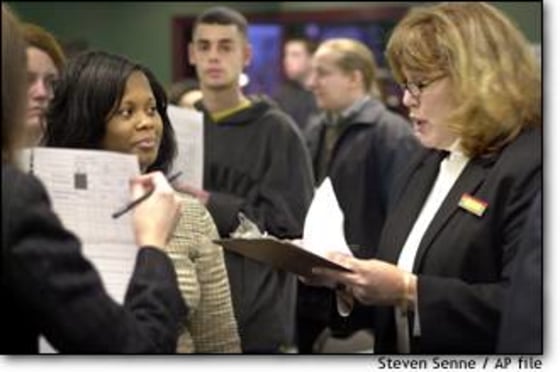In June 2001, Sandra was riding the wave of the dot-com bubble, earning $45,000 plus stock options as an administrative assistant at a major Silicon Valley technology company. Then the wave came crashing down.
In the 20 months since Sandra was laid off - along with more than 1,000 others at her company — she has managed to find just one job, at a travel agency, and that only lasted three months. She has given up her apartment, moved back in with her retired parents, and is hoping to land a job as a receptionist and filing clerk at a law office — at $28,000 a year.
“It’s a step down, but there is nothing really out there,” said Sandra, 37, who asked that her last name not be published. “There’s a lot of competition out there applying for the same kind of jobs.”
Sandra is far from alone. The problem of long-term unemployment is becoming a hallmark of the current economic downturn, and an important factor in the nation’s declining consumer confidence.
The jobless rate edged up to 5.8 percent in February, and a whopping 308,000 jobs were lost in the economy. But even those lousy headline numbers fail to tell the whole story about a job market that has shed 1.6 million jobs since April 2001.
Nearly 2 million jobs have been lost since hiring peaked in March 2001. In February alone, 8.5 million people were unemployed, a 2.8 million increase since the fall of 2000. The number of long-term jobless tripled during this period. About 1.9 million people have been jobless for 27 weeks or more, comprising 22 percent of the total — the highest level in more than a decade.
“Looking at the overall employment number per se doesn’t tell you as much as you’d like to know,” said John Silvia, chief economist of Wachovia Securities. “The nature of unemployment has changed.”
As more people move from the typical state of temporary unemployment to long-term unemployment, the social and economic costs rise, he said.
“People lose their attachment to the job force,” he said. “They lose the skills they have developed. Any kind of computer skills they have get rusty.”
Less skilled, marginal workers who were swept into the work force in the last years of the boom, when the jobless rate dropped below 4 percent for the first time in three decades, mostly have been sent back to the sidelines.
It is hardly surprising that 30 percent of those surveyed by the Conference Board last month reported that jobs are “hard to get,” the highest level in nine years. While the threat of war and declining stock prices have taken their toll, many analysts believe concern about employment is the No. 1 factor driving consumer confidence to its lowest level in nearly a decade.
John Challenger, chief executive of the outplacement firm Challenger, Gray and Christmas, said he has been seeing an increase in the number of people who were able to find work in the late 1990s but are now “falling through the cracks.”
“I do think that is a real cause for concern,” he said. “These are people who can’t seem to find their way back into the system. I think in every community people are aware of those people around them who have been out of work for a long period of time and can’t find their way back. By the nature of what I do I’m seeing a lot of those people.”
Challenger’s firm reported this week that U.S. companies announced plans to eliminate 138,000 jobs last month, up from 132,000 in January and the highest total since November. Challenger said increased war talk beginning last fall has triggered a new wave of layoffs as companies have grown nervous about prospects for global trade and have turned back to cost-cutting to maintain profit margins.
In another gloomy sign, the Labor Department said Thursday that initial claims for unemployment benefits rose for a third week in a row. The four-week moving average, which smooths out weekly variations, is at a two-month high of 408,750, a level that generally indicates rising unemployment.
The Associated Press contributed to this report.
